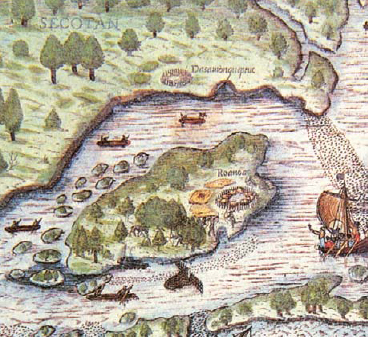
With the benefit of hindsight we can see that the belief that Drake’s raid would help prevent a war was incredibly naive. The idea was that it would give King Philip pause, and make him consider the consequences of an all-out war with England. Of course, Drake’s raid achieved exactly the opposite. At the time King Philip was embroiled in a long and costly war against the Dutch Protestant rebels. His commander, the Duke of Parma, captured the city of Antwerp in August 1585, which safeguarded Spain’s earlier conquests in the Spanish Netherlands. He was irritated by overt English support for the rebels, and so before launching a final offensive against the Dutch, King Philip felt he needed to deal with the English problem once and for all. That effectively meant invading England.

The unusual location of England’s first New World colony is clearly seen in this engraving by Theodore de Bry. Roanoke Island is protected from the Atlantic by a chain of barrier islands, and could only be reached by small boat.
Back in Spain, King Philip’s advisors argued that Drake’s success would encourage others, and the seas would be filled by English privateers, all eager for a share of Spain’s riches. The first of these privateers were already at sea. Only by defeating England could Spanish sea communications be protected, and the security of her overseas empire preserved. Consequently King Philip asked his leading commanders, the Duke of Santa Cruz and the Duke of Parma, to draft plans for an invasion. This set in train the events which would lead to Spain’s ‘Great Enterprise against England’ – the Spanish Armada of 1588.

Drake’s assault on Cartagena, as depicted in the engraving by Baptista Boazio in 1588. As in his other maps, Boazio shows several actions at the one moment, including the probing of the harbour, Drake’s amphibious landing and Carleill’s dawn assault.
When the Spanish Armada appeared, Sir Francis Drake played a not insignificant part in the fighting, as did many of the ships and men who accompanied him to the Caribbean. However, the Spanish Armada was defeated as much by luck as naval prowess, a combination of contrary winds, unfavourable tides and unseasonable gales all played their part in thwarting King Philip’s great invasion force. Although the war would drag on after the death of both Elizabeth and Philip, neither side achieved a decisive victory. Other expeditions would be launched against the Spanish overseas empire, but none achieved the success of Drake’s great expedition of 1585–86. For their part the Spanish learned their lesson, and not only fortified their treasure ports, but they now provided their treasure ships with powerful escorts. Drake’s raid proved to be the last of its kind. The ageing Drake and Hawkins would both succumb to disease during a last raid on the Spanish Main in 1595–96, and their deaths marked the passing of an era – the age of the Elizabethan Sea Dogs.